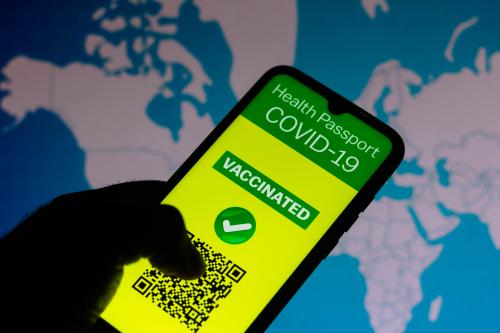Now is the time to launch a Federal Cloud Modernization “moonshot” to modernize all practical legacy civilian IT systems within a decade. COVID vividly demonstrated the importance of our IT systems to a resilient and robust economy. Yet from security breaches to delayed tax processing, the weaknesses of government IT systems are well known.
In ITIF’s Secrets from Cloud Computing’s First Stage report, I show how cloud computing offers a better way to modernize federal IT. This will bring improved citizen services, lower operating cost, and—as repeated security breaches highlight the need for—better cybersecurity. The initiative should be led by the Federal Chief Information Officer (CIO) Council, the White House Office of Management and Budget (OMB), and the Federal Chief Technology Officer (CTO), with deep engagement by agencies and support from Congress. The Technology Modernization Fund (TMF) can serve as a starting point, with IT modernization funding targeting $10 billion a year.
This will involve modernizing thousands of systems. We will need to develop new agile migration methodologies and stand up “migration factories”. The U.S. Digital Service can play an important role here. Leadership must also rally the federal IT industry partner community to implement system migrations at scale. It’s not just funding—the initiative needs a robust program office and careful governance. Ten years is arguably too long, but even so this will be a challenge to achieve; once it starts showing success, lessons learned should be applied to modernize state and local government IT.
Why Modernize?
Cloud better enables the government missions and programs that the American public depends on. Cloud computing is a powerful platform that provides hundreds of IT services with a common architecture, security model, development tools, and management approach. This now provides a better way to automate and scale modernization in a more repeatable fashion. Cloud computing has 31% lower operational costs than comparable on-premises infrastructure, and even greater savings when people and downtime costs are included Elsewhere, I show that cloud is a more flexible and automated system that enables rapid changes to new demands. This provides better, more reliable citizen services, whether they be innovative public facing websites, faster payment processing, or veterans’ health care scheduling. Moreover, cloud provides substantially stronger security that is built into the platform by design. While the recent cybersecurity executive order makes important process and policy changes, the systems and code still need to be modernized.
The Importance of Leadership
The initiative should be led by the Federal CIO Council, OMB, and the Federal CTO. Agency and department leadership, in addition to CIOs, need to be deeply engaged to support IT modernization. DHS’ Cybersecurity and Infrastructure Security Agency should be an integral partner. Congress will need to support funding and will expect transparency. The CIO Council should set a baseline of systems to modernize and then set measurable, agency-specific outcome goals such as the number of target applications, servers, and petabytes of data moved, cost savings, and priority programs supported. Federal CIOs will need to prioritize all major systems and provide plans to move them in smaller stages, learning along the way. A cloud modernization moonshot program office is crucial to manage the program and should issue public progress reports at least bi-annually, in addition to managing ongoing performance metrics, timelines, and cost savings.
Funding and the TMF
The U.S. federal government is the largest technology buyer, spending well over $100 billion a year on IT. However, we need to get out of the trap where annual appropriations only pay for ongoing operations, leaving little funds to move to lower-cost, more capable systems. As Congress and the President negotiate an infrastructure modernization package, digital infrastructure and Federal IT should be included. The federal Technology Modernization Fund provides funding and expertise to upgrade and transform IT systems. Now is the time to build on the lessons learned and scale it. Funding should be increased to roughly $10 billion a year, or roughly 10% of the federal IT budget. This is substantial but would place the government at the low end of the target share of IT spending dedicated to modernization. The TMF repayment requirement should be aggressively lowered for moonshot projects, with more funding for the most important systems. The OMB, in consultation with Congress, should develop criteria for funding. Funding can prioritize target public domains including health, education, security, and benefit payments and fraud.
Rallying the federal IT industry partner community to modernize workloads and get migrations done
The federal government relies on federal IT-focused companies to provide IT services, and private industry will be integral to moving thousands of systems to the cloud. New migration methodologies will be needed to move workloads at this scale, with attention to related mission work-flows and governance. The U.S. Digital Service has an important role to play here. “Migration factories” that move IT systems and data in more standardized, repeatable processes will be needed. Moving to the public cloud should be the desired default choice due to its better cost, operational flexibility, and agility. However, private clouds for sensitive data and on-premises modernization remain options where appropriate. They should require specific justification and approval, with criteria developed by OMB and the Federal CIO council.
Ambitious but achievable
Earlier “Cloud First” and “Cloud Smart” policies helped start the federal move to cloud. Ten years later, it’s time to build on them with additional action. The goal is ambitious. Yet the federal Data Center Optimization Initiative, for example, targeted closing ~10% of federal data center square footage a year, and included goals such as cost savings, server utilization, and energy efficiency. For sure there will be setbacks along the way. But the initiative should learn from these and course-correct. A parallel initiative at the Department of Defense for national security systems could follow. Lessons from the federal level should then be applied to a state and local government modernization initiative. We are moving to a digital economy to generate growth, resiliency, and improve social opportunities. A robust government IT capability is integral to this progress.
Amazon is a general, unrestricted donor to the Brookings Institution. The findings, interpretations, and conclusions posted in this piece are solely those of the authors and not influenced by any donation.





Commentary
Now is the time for a federal cloud modernization moonshot
July 28, 2021